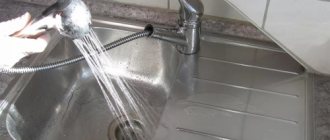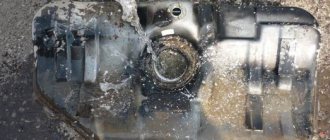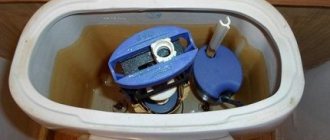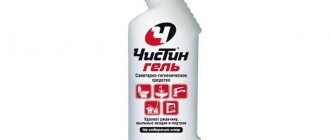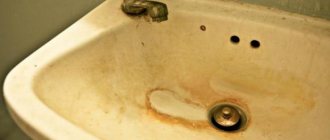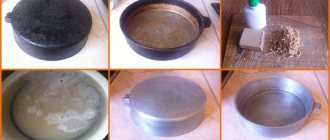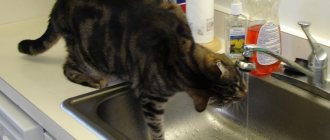The toilet cistern is susceptible to contamination, which affects not only the visible parts, but also the internal ones, which can damage the plumbing and cause other troubles. This is why it is important to know how to clean the inside of a toilet tank at home.
The toilet tank is susceptible to various contaminations. Dirt accumulated on the walls of the tank can lead to leaks and other damage, so it is important to promptly clean the internal surfaces of plumbing fixtures and follow preventive measures
You can deal with plaque, rust and other contaminants yourself, using improvised or professional means. When cleaning, strictly follow the tips and recommendations collected in the article.
Causes of pollution
Common causes of concern are rust and limescale deposits. They can be caused by urinary stones that corrode the walls of the plumbing. To prevent its inevitable settling, you should clean it regularly using detergents and a brush. Toilet tablets are also convenient to use: they are placed in the tank so that when flushed, cleaning components are distributed that can deodorize and wash away urinary stones.
Limescale and rust deposits are formed due to the poor quality of the liquid supplied in the water supply system; old metal and cast iron pipes are also risk factors. After the service life has expired, the communications rust and oxidize, as evidenced by the red marks on the toilet bowl. Plumbers recommend promptly replacing outdated products with polypropylene or metal-plastic pipes.
Special filters installed on the inlet channels are capable of catching sand, foreign particles, iron compounds - all of them have a destructive effect on working units and surfaces of plumbing fixtures. Also, red marks can form due to unregulated drainage: iron salts are deposited along the edges of a constantly emerging stream of water. To avoid rust, you need to adjust, clean or install a new float in the toilet tank.
Plaque and rust are formed due to poor water quality
The quality of the material used as the basis for plumbing also matters here. Low-grade earthenware is distinguished by an abundance of micropores and a rough surface; iron salts, dirt, and urinary stone quickly settle on it. Plaques are much less likely to form on porcelain and glazed earthenware.
How to remove not too old plaque
It is enough to clean it weekly with one of the homemade or special industrial preparations and soon there will be no trace left of the yellow coating. To prevent damage to the plastic itself, before bleaching the yellowness of the toilet lid, it is advisable to test the effect of various products on a small area of it.
Table vinegar
Ordinary 9% vinegar perfectly removes both limescale and urinary stone deposits on the inner surface of the toilet, but if there is a little yellowness on the lid, it will also cope with this problem:
- a glass of vinegar is heated to approximately 40 °C;
- a paste of soda slaked with warm vinegar is applied to the yellow areas;
- lower the lid and leave it in this state until the morning.
In the morning, just rinse off the remaining soda with water.
Toilet tank cleaning products
Specialized sanitary and hygienic products can get rid of hardness salts, waste products, iron oxide contaminants, poorly soluble urates and oxalates. Solutions must deodorize and disinfect.
The following groups of specialized household chemicals are distinguished:
- abrasive substances containing fine-grained solid components of natural or artificial origin, for example, pumice, chalk, electrocorundum, quartz sand;
- acid preparations (usually hydrochloric based) effectively remove rust and limestone. The cleaning solution is poured generously over the problematic, affected internal areas of the toilet tank, left for half an hour and vigorously brushed. If necessary, repeat the procedure;
- alkaline sanitary products are used in a similar way. In both cases, it is important to follow safety precautions and use gloves and a mask as personal protection;
- Rulers for automatic cleaning are placed in the tank or hung on the edge of the toilet; they gradually dissolve with each flush and evenly clean the surface. You can find weakly alkaline blocks, surfactant mixtures, acidic compounds, products with bleaches and flavors.
The classification by consistency includes solid preparations in the form of granules, powders and tablets, paste-like - suspensions, gels and emulsions - and traditional liquid. It is also necessary to distinguish between potent and gentle mixtures, the latter include Pemolux, liquid detergents, laundry soap, Cinderella.
Among potent household chemicals, the following names are popular:
- Cillit Bang gel,
- Toilet duckling,
- AIST-Sanox,
- SARMA,
- Chistin Sanitary,
- Comet anti-rust.
AIST-Sanox - toilet cistern cleaner
Domestos and Sanfor have proven themselves well.
Professional methods
Using store-bought cleaning products is the easiest way to solve the problem of removing rust from the toilet. By the way, unsightly stains can be not only on the toilet, but also in the tank. Rust removers will be the same. Moreover, if you have replaced the toilet, but the tank remains old, then be sure to take care of the issue of cleaning it. Otherwise, the new “white friend” will soon also become overgrown with plaque. You can choose one of three types of products:
- abrasive powders such as Pemolux. The cleaning process consists of applying abrasive to a cloth and wiping off the rusty stain. After a 15–20 minute procedure, the remaining product is washed off. The option is quite tedious, despite its effectiveness. A significant disadvantage is that as a result of the action of the powder, microcracks are formed on the surface of the toilet or flush cistern, which are even more susceptible to contamination. And next time, scrubbing may not be so successful, since the stains will eat into the pores of the material from which your bathroom is made. For the same reason, rust cannot be removed mechanically, that is, scraped off with sharp objects;
- alkaline foods. For example, Domestos. Due to the sodium hydroxide content, the rust will dissolve without damaging the surface. Simply apply the product to the problem area for 15–20 minutes and then rinse off. There is practically no effort, but for stubborn stains the method may not be effective.
Liquid cleaning products in bottles with a curved neck are convenient for applying under the rim of the toilet bowl
Effective tank cleaning recipes
In order to rid the toilet tank of rust and prepare it for cleaning, it is necessary to flush the water and temporarily turn off its supply. Next, you should disassemble the tank: in older models, you simply remove the lid; in new ones, you must first unscrew the ring that encloses the drain button. Next, you need to remove the fittings to make it easier to wash all the components, the valve and the remaining free cavity.
Clean with powder
If you don’t have special household chemicals on hand, you can easily cope with the task using washing powder. Guide to action:
- pour at least 4 liters of heated water into the drain tank;
- add 4-5 tbsp to the liquid. spoons of powder, stir until it completely dissolves;
- the mixture should be left in the plumbing unit for several hours, then it can be flushed down the toilet. If plaque remains on the walls, it can be easily removed with a sponge.
If the container is not cleaned, then you will have to use a more aggressive recipe.
We use battery electrolyte
It helps fight limescale. Apply a small amount of liquid to the contaminated walls of the container and leave for 4-6 minutes. Next, you should wash the device using a brush or cloth. When using this product, it is necessary to protect the skin of your hands with gloves and your respiratory organs with a mask.
Cleaning with Coca-Cola
You need to drain the water from the cavity in order to then pour the drink into it, and the tank is left to soak overnight. After Coca-Cola is flushed down the toilet in the morning, the walls should be wiped with a hard sponge. The drink is able to cope even with old stains, it is very effective.
Sanding
The tool will help remove deeply ingrained plaque. First, you need to wash the toilet with your usual cleaning agent, then rinse the tank and sand its walls. At the final stage, you need to rinse the plumbing fixtures again using household chemicals. This method is considered aggressive, since with a careless approach there is a high risk of characteristic scratches appearing after the abrasive.
Possible uses of toothpaste
This method is relevant for combating fresh plaque; it will not cope with persistent stains. A closed tube of toothpaste needs to be pierced and placed in a filled container, gradually dissolving, the active substances will fight plaque, refresh the smell, and disinfect.
We use whiteness
A chlorine-containing product will help get rid of soft plaque; although it is cheap, Whiteness is considered highly effective. It is distributed on the inner surfaces of the tank, left for 30-40 minutes and washed off; the container must be rinsed several times. The solution will not cope with hard deposits, but will quickly remove fresh dirt and disinfect the bowl.
Cleaning with vinegar
First you need to remove fresh deposits - wipe the inside of the toilet cistern with a soapy sponge. Next, the most contaminated areas should be poured with vinegar and left for several hours. After the specified time has elapsed, you need to brush off any residual dirt with a stiff brush and rinse the tank. Citric acid can be used in a similar way.
Vinegar is a folk remedy for cleaning toilet tanks.
Use of dish powders
Pemolux, Cinderella, Biolan, usually used to remove carbon deposits from thick dishes, are also useful in caring for plumbing fixtures. They need to be distributed on the moistened walls and treated with a brush or sponge, thoroughly rinse off the residue.
Where does plaque come from and why is plaque dangerous?
Plaque on the walls of the cistern appears as a result of the deposition of salts and rust. As a result, a thick layer of favorable environment for the proliferation of pathogenic flora is formed. Microbes, fungi and viruses, being in the sludge, multiply exponentially at room temperature, causing irritation of the skin, mucous membranes and more serious diseases.
The harder the water, the faster deposits of heavy metals accumulate. Along with calcium, magnesium, and iron, particles of limestone suspension fall out of the water. All together forms a dense calcium layer. It is porous, which is favorable for microorganisms, but it is extremely unpleasant to work with when cleaning.
To decide how to effectively clean a toilet tank, you need to analyze the degree of contamination. Only by objectively assessing the scale of the disaster can one begin to select funds from among those at hand.
Sequence of washing the fittings
The tank often leaks due to contamination of the seat and petal valve with rust, limescale, bacteria, and salts. To prevent premature wear of working units, it is necessary to regularly care for the fittings:
- Drain the tank and turn off the water supply using the valve. Next, when disassembling, you need to remember the sequence of removing the components in order to reassemble them in the reverse order.
- Remove the drain lever by unscrewing the button. In order to get the drain mechanism, you need to unscrew the fittings, carefully turning them counterclockwise. After the working unit is released, you should carefully inspect it and the walls of the cavity for defects.
- Using a rag, clean the inner walls.
- The valve seat, that is, the area to which the seal is adjacent, must be carefully freed from plaque and dirt. It is important that the impression is not damaged.
- The tank should be rinsed by manually pouring water into it.
- The edge of the rubber valve seal must be slightly pulled towards you to remove it from the groove. After the deposits have been removed from all components of the fittings, you need to rinse the system under running water.
All processed parts should be connected in reverse order; it is necessary to assemble the rubber seal, operating mechanism, cap, plug and button with a ring.
To check the quality of the drain, you need to activate the water supply to the container: first you should make sure that the connections are tight, then that the drain is complete.
Method 4 – skin
This product will allow you to get rid of plaque that has become deeply embedded in the walls of your plumbing. It is used like this: first, wash the toilet with any household chemical, rinse the surface several times, and then use sandpaper to remove any remaining plaque. After this, the toilet is washed again with detergent.
Important:
This product must be used very carefully so as not to damage the walls of the plumbing. Unless absolutely necessary, it is better not to use it at all.
Prevention measures
If you follow the recommendations of plumbers, you can avoid the accumulation of plaque on the walls, wash the equipment less often and with less effort. Firstly, you need to monitor the pipelines: rusty metal communications used in the house cause the formation of a red coating. Plastic pipes are considered less problematic.
Directly into the tank you can place special products in the form of tablets designed to protect against plaque. Such household chemicals may also have a gel consistency. Every few weeks, it is advisable to remove the tank cap to ensure its proper condition and promptly eliminate soft deposits.
What not to use
The following should not be used when cleaning the tank:
- boiling water and hot water (high temperatures can cause earthenware to crack, and plastic items to become deformed);
- metal brushes (scratches are a favorable condition for the development of plaque in the future);
- sand and other coarse abrasives.
If the toilet is connected to plastic pipes, do not use electrolyte or products containing hydrochloric acid. The chemical corrodes the plastic and causes the pipes to leak.
Hydrogen peroxide + ammonia
- Mix hydrogen peroxide and ammonia in equal proportions.
- Pour the resulting product into a spray bottle.
- Now you need to remove all excess moisture from the surface of the toilet.
- Spray the prepared liquid onto the surface of the toilet and leave overnight.
- In the morning, clean any remaining rust stains with a sponge.
This product will not only cope with rust, but will also restore the whiteness and shine of the toilet surface. This product is environmentally friendly.
Mustard powder
- Dilute mustard powder with water until you obtain a mushy consistency.
- Apply the resulting slurry under the toilet rim and on the inner surface of the toilet bowl.
- Before application, it is necessary to wipe the surface from excess moisture so that the mustard powder does not flow down the walls.
- Leave overnight for best effect. In the morning, clean with a brush or sponge and rinse.
This method is environmentally friendly for people and pets.
Method 7 – toothpaste
You can clean the inside of such plumbing fixtures using regular toothpaste. They use it according to the principle of toilet tablets: take a tube of this product, pierce it and immerse it in water. This product will not only remove plaque, but also disinfect plumbing fixtures and remove unpleasant odors.
Important:
The presented method will only be effective if the plaque in your toilet is quite fresh. If the situation is very advanced, toothpaste will not fix it.
